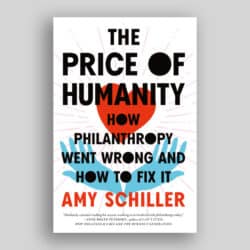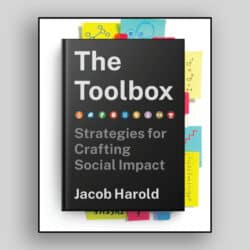Papers presented at the Special Forum at The State West Hotel, Mississauga, Ontario, convened by the Canadian Council of Christian Charities September 29, 1999
Published by Canadian Council of Christian Charities, 1999
REVIEWED BY DAVID STEVENS
Goodman and Carr LLP, Barristers and Solicitors, Toronto and Editor, The Philanthropist
This book is a collection of six essays, which, for the most part, address the status of religion as charity in law. The essays are all very thoughtful and well written and the collection as a whole provides a foundation for further reflection on the position of religion, especially the legal position of religion, in contemporary society.
All of the essays were written by individuals who appear to have an understanding and sympathy for the “religious point of view”. Perhaps, in general, it is not a sound strategy to hold a conference or publish a collection of essays where participants present points of view which are mutually reinforcing. In some cases, however, it is useful to avoid dialogue with opposing points of view: in modern debates about the place of religion in society, it is certainly debatable whether anything is to be gained from dialogue with modernists, post-modernists and others holding views antithetical to religion.
The opening essay by the staff of the Canadian Council of Christian Charities (CCCC) is entitled “Determining the Boundaries of Charity”. This essay explores the meaning of charity in its religious, secular and legal senses. It picks up from and, to some extent, advances (while criticizing), the chapters on the definition of charity in the Ontario Law Reform Commission’s, Report on Charity. That Report (I was the author), attempted in several chapters to develop a “secularized” definition of charity, derived largely from its religious significance, in a way that was appropriate for a public or government publication. This first essay delves deeper to reveal a deeper religious significance to the formulations developed in the Report on Charity.
The second essay by the father-daughter team of Blake Bromley and Kathryn Bromley is entitled “John Pemsel Goes to the Supreme Court of Canada 2001: The Historical Context in England”. Blake Blomley is a prolific and thoughtprovoking author, as readers of this journal know, and a talented and much-indemand charity lawyer. Kathryn Bromley’s essay on “The Advancement of Religion in the Age of Fundamental Human Rights” won The Philanthropist Award a year ago and was published in Volume 16, Numbers 2 and 3 of The Philanthropist. Their essay in this collection is an extensive reflection on the historical treatment of charity under the law, written through the optic of a possible application by John Pemsel, [protagonist in the landmark case Commissioners for Special Purposes of the Income Tax Act v. Pemsel, [1891] AC 531 (H.L.)], for charitable status in Canada in light of the Charter. This is an interesting approach because the purposes at issue in the Pemsel decision included “maintaining, supporting and advancing the missionary establishments among heathen nations”. The essay by Blake and Kathryn Bromley provides the basis for an informed reflection on how an organization with such purposes might be treated in today’s political climate and under the Charter. The Bromleys conclude (at page 64):
Although missionary work is clearly the “advancement” of religion, proselytizing without actively engaging in “good works” will seem out of step with the age. To date, the Charter has been invoked as a means of protecting the rights of minority religions rather than expanding the privileges of the religious majority. Minority religions are an important component of multiculturalism in Canada. The issue which people will find threatening is a religion’s commitment to converting others. While some of the judges might want to protect the “legal” privileges historically extended to religion, the Court will be troubled by the extent to which tax benefits implicate the state in matters of religion.
All in all an interesting reflection.
Reverend Francis G. Morrisey, OMI writes on “The Relationship Between Religious Organizations, the Voluntary Sector and Governments”. He writes from a Roman Catholic perspective on the role of religion in contemporary society and looks at the relationship between religion and charity and the challenges facing religion as a result of the “modernization” or “secularization” of society. One of the principal elements of his analysis is the Second Vatican Council’s Statement of the Basic Activities of Religion as an Expression of Faith. He writes about the seven forms of lay activity as follows:
1. To foster the protection of life;
2. To promote public worship;
3. To teach the faith;
4. To be involved in works of Evangelism;
5. To carry out works of piety;
6. To carry out works of charity; and
7. To animate the temporal order with Christian spirit.
The seven points form the basis of his reflection on the role of faith in contemporary society.
Patrick J. Boyle, a tax partner at Fraser Milner in Toronto, writes about “Defending Christians Against the Emperor’s Lions”. His essay contains much useful information concerning how religions and religious activities have fared in the courts and in the provincial and federal bureaucracies in recent years.
Iain Benson writes on “Religion and the Canadian Charter of Rights and Freedoms: Private Beliefs or a Public Benefit”. Benson is a barrister and solicitor and, since 1994, a senior research fellow for the Centre for Renewal in Public Policy, Ottawa. The Centre for Renewal in Public Policy is a think tank “dedicated to the connections between public policy, culture, moral discourse, and religious conviction”. His essay deals with the phenomenon of “privatization” of religion in Canadian society. In a sense, it is complementary to the Morrisey essay which describes religion as essentially a public, as opposed to a private phenomenon, yet the ethos of the age in law reflected in the Canadian Charter of Rights and Freedoms and the jurisprudence under the Canadian Charter of Rights and Freedoms is that religion is a strictly private phenomenon. The essay explores how these competing world views have clashed in the jurisprudence.
The last essay by Ronald C. Knechtel “Religious Organizations as Registered Charities” looks carefully at the definition of religion in Canadian jurisprudence. Ron Knechtel is a senior advisor with the Canadian Council of Christian Charities and a former partner with Ernst & Young in Toronto. His writing on the charity and nonprofit sector is well known to Canadians with an interest in this sector as well as to long-term readers of The Philanthropist.
I highly recommend this book to anyone with an interest in the topic. It is the only extensive treatment of these topics in the Canadian setting of which I am aware. The contributions are uniformly good, and both knowledgeable and perceptive. We are probably entering a period of serious reflection on the relation between charity and religion. There are a number of movements afoot which seek to develop a more refined or precise legal definition of charity. Those discussions will undoubtedly raise questions about the role of religion and charity in contemporary Canadian society, especially in light of the Canadian Charter of Rights and Freedoms. The essays in this volume provide a sound basis for that reflection.
Partnerships: Profits and Not-For-Profits Together
By Martha Parker
Published by The Muttart Foundation, 1999
REVIEWED BY DAVID STEVENS
Goodman and Carr LLP, Barristers and Solicitors, Toronto and
Editor, The Philanthropist
Martha Parker’s book is published by the Muttart Foundation as part of its Muttart Fellowship Program created in 1996. As stated on the inside cover of the book, the purpose of the Muttart Fellowship Program is to “develop research and other materials that will benefit the charitable sector in Canada….[and to] provide senior managers within the social services with an opportunity for a sabbatical year—a chance to recharge and renew themselves”.
The purpose of Martha Parker’s study is to “look at the context of why corporations and not-for-profits seem to be moving toward a new way of interacting with each other and very definitely a new way of impacting the communities where each live and work”. The study develops 11 corporate case studies which examine the “evolution of each company’s involvement with its community”. The study attempts to develop correlations between “where leading . . . corporations and not-for-profits have moved from and where they appear to be going”.
The book is based on the following reflection:
For many corporations in Canada, the need to be more strategic with philanthropic budgets may have started simply as an exercise to deal more effectively with the volume of requests coming in the door. That process dovetailed with a variety of other push/pulls to dramatically grow in dimension. Social marketing, cause marketing, and economic development strategies are more consciously used to differentiate products and build stakeholder trust. Many companies want to be good neighbours, and to have impact on the issues their employees, customers, and the community at large care about.
Social responsibility and corporate citizenship are requiring a larger share of the thinking of corporations who want to be both learning and leading corporations, particularly as society demands more accountability for their actions. Business is more aware that long-term economic success is increasingly dependent on a healthy work environment and that means a healthy community in which to work. Social and economic concerns are mutually important.
One of the major findings of Martha Parker’s study is that today’s business is more inclined to fund “strategic initiatives”, “those geared to complement business interests while offering pro-active opportunities to have impact on serious social issues”. This is in contrast to what was perceived as the previous strategy, noted by the nonprofits, of business seeking to promote or fund only “causes”.
Martha Parker quotes a very interesting statement of John Brown, CEO of the British Petroleum company in a 1997 interview with the Harvard Business Review. Brown was asked what he thought were the qualities of a distinctive organization. Martha Parker quotes the response:
It’s people who are highly motivated, understand exactly what they have to do to create value, can see the results of their actions, and have a sense of ownership.(sic) They excel at building and using knowledge capital, which means accessing and applying knowledge that exists both inside and outside the company. They excel at forging distinctive relationships.
She observes that all of the organizations and companies included in her study try to meet Brown’s definition.
She outlines the objectives of her research project as follows:
• to identify and describe common elements/learnings(sic) that could help and motivate business and not-for-profits to build partnerships or strategic alliances;
• to provide material that would generate discussion on emerging partnership issues such as partner choice, ethical concerns, and language issues;
• to document some of the best practices of successful Canadian corporate/not-for-profit partnerships.
The book is divided into six chapters totalling 72 pages plus a series of 11 case studies contained in appendices, for a total of 149 pages. The first section contains an interesting analysis of the motivating factors driving both corporate philanthropy and not-for-profit interest in the corporate sector. It closes with a discussion of what a real partnership is between a not-for-profit corporation and a company.
This is a creative and useful study particularly because there is not very much writing on corporate philanthropy in Canada. Any Canadian company thinking about becoming more involved in community issues will want to read and spend time reflecting on these case studies.
Foundation Management in Canada: An Introduction for Trustees (2nd ed.)
By HSBC Asset Management (Canada) Ltd.
Published by HSBC Asset Management (Canada) Ltd., 1996
REVIEWED BY DAVID STEVENS
Goodman and Carr LLP, Barristers and Solicitors, Toronto and
Editor, The Philanthropist
This publication is a handbook for directors and trustees of foundations and their agents.
There are four main sections of the book. The first is a brief examination of the history of foundations in Canada and the growing importance of foundations and endowment funds. The second section provides a brief review of the private law and income tax law governing foundations. The third section is a review of finance and accounting in the nonprofit sector. The final section deals with the main considerations involved in managing investments for foundations.
The unique perspective of this book is described in the first section:
Foundations differ from other institutional investors in at least two important ways. The first is that foundations have required spending. That is, they cannot reduce their spending below a certain required minimum. This means that they have no way of compensating for investment returns that are lower than expected. The second is that the goal of most foundations to exist in perpetuity is at odds with the way many of them go about investment; if returns are too low, perpetual existence will be impossible. The essential problem for most foundations is that they have been very conservative in the past, and their investment income has not sufficiently outpaced their spending requirements. Over time, this kind of investment pattern is likely to put most foundations out of business. This handbook has been written to heighten trustees’ awareness of this unfortunate, potential outcome.
The first two sections contain information that is generally available. They appear to have been included in order to provide a comprehensive handbook.
The third section on finance and accounting provides a basic overview of accounting considerations in operating a foundation. This is a good and useful review. It should be of particular use and interest to foundation boards where there are individuals with limited exposure to accounting topics. Towards the end of this section there is a subsection on “Corporate Governance”. There are two quotes in this section of some interest, one from the writing of John Carver who advocates boards that are pro-active, explicit about their values and long-range in the majority of their concerns. The ideal board “avoids both meddling and overstamping”. The second extensive quote is from the Toronto Stock Exchange publication Where Were the Directors?. That report developed recommendations for effective corporate governance in the business sector, not the not-for-profit sector. Nonetheless, the role of a board in both types of organization is similar. It is therefore appropriate for a nonprofit board to think about adapting the Toronto Stock Exchange recommendations on corporate governance, as appropriate, to its organization.
The last section summarizes basic principles of investment management, adapted to the foundation context. There is an interesting summary of an article by Professor Robert Heinkel of the University of British Columbia’s Bureau of Asset and Management (Faculty of Commerce). Professor Heinkel’s research developed four potential methods for payment and reinvestment of a foundation endowment:
a) pay out all interest and dividends;
b) pay out a certain percentage of the portfolio’s quarter-end value;
c) pay out a fraction of the quarter-end value, minus initial value multiplied by the rate of inflation for the quarter; and
d) pay out a three-year moving average of all interest and dividend payments.
Professor Heinkel’s studies tracked the effects of these different payout methods on foundation endowments. He concludes:
Different endowments might prefer different methods. An endowment that needs capital accumulation and can accept somewhat more volatile payments could use the “constant proportion” payout method [method (b)]. Another endowment which can accept lower growth but needs consistent payments, can choose either the standard “all interest and dividends” [method (a)] or the smoothed interest and dividends [method (d)].
This section of the book closes with subsections on balancing short-term and long-term goals and on the investment evaluation process. One of the conclusions of the chapter is that the payout rate of 4.5 per cent required under the Income Tax Act does leave “plenty of room for a foundation not only to grow its assets but to continue its contributions to charitable endeavours and to exist in perpetuity while doing so”. However, the book notes that “this is only true for foundations willing to tolerate more than the traditional level of risk in their portfolios by investing more heavily in equities”.
There are a number of appendices, including a glossary of investment terms and a bibliography.
This is a useful handbook which I would recommend for foundation trustees and directors who are new to the field and want a clear summary of their obligations. The most useful part of the book is the fourth section dealing with investment management. The authors of the book state that it is published for a British Columbia audience; however, I found that most of the information was applicable to foundations that operate anywhere in Canada.


